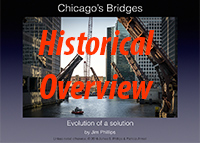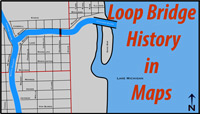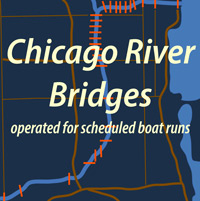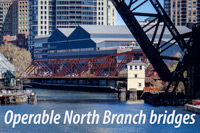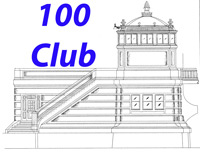
A view of the Du Sable Bridge at N Michigan Avenue, considered by many to incorporate all of the ideals of the City Beautiful Movement and the 1909 Plan of Chicago.
A discussion of early twentieth century Chicago and its built environment must include mention of The Plan of Chicago published in 1909. The Plan was a long-range view of what the city could become. It had its roots in the City Beautiful Movement and the 1893 World's Fair held in Chicago. The Commercial Club of Chicago was the driving force behind the Plan and architects Daniel Burnham and Edward H. Bennett were the masterminds. The focus of the Plan was to create a city that would be free of the strangling effects of congestion to aid in the conduct of industry and business while creating a pleasant environment for the residents for the city.
The impact of the Plan on bridges was in two areas. First, their location and design needed to ensure efficient movement of people and goods into and out of Chicago's Loop. Second, the bridges needed to accomplish their primary objective with a design that complemented the beauty of the city. While there were some architectural considerations in the bridge components themselves, most of the architectural attention was focused on the bridge tender houses, abutments, staircases, and railings - as shown in the photos.

Bridgehouse details - Washington Blvd 1913 - first to begin implementation of the Plan's ideals (upper left -©2009 Patricia Armell); La Salle St 1929 (lower left); Du Sable bridge at N. Michigan Ave (right)
An example of the concern for the aesthetics of the bridges is evident in a statement made by James W. Pattison in the May 7, 1911 Chicago Daily Tribune. Mr. Pattison, secretary of the Municipal Art League, said: “The whole trouble with Chicago bridges is that they are all stock pieces of engineering. It never seemed to occur to anybody to ornament them. A bridge which is at once sturdy and staunch and beautiful to boot is what we want here – something graceful in shape and form and which is strong and useful as if built in the old methodical way. There ought to be some art deliberately thrust upon Chicago. Chicago can have fine bridges if she will pay for them. They're expensive, we admit, but they're certainly worthwhile.”
Twelve of these bridges were built between 1913 and 1930 when Edward Bennett was the architectural consultant for the Chicago Plan Commission. His training at the Ecole de Beaux Arts in Paris and his philosophy of city planning is clearly reflected in these bridges. The remaining bridges reflect the architectural style of the eras in which they were built.

Bell on the W Monroe St bridgehouse 1919 (left); Door of the N Franklin St bridgehouse 1920 (right) - both photos ©2009 Patricia Armell

